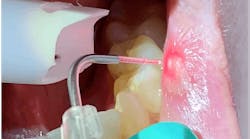Thinking of hiring an associate in your dental practice? Here are some guidelines for success
Some relationships between the associate dentist, senior dentist, and the rest of the team are matches made in heaven, while others seem doomed from the start. During my many years of consulting, I have researched what it takes to create a successful multi-doctor practice, and made notes about why so many of them fail. At one point in my research, I found problems in nearly 75% of the offices I visited. That only about one quarter of offices were working with minimal stress.
What are some of the ground rules for a successful relationship, and whose job is it to see that the relationship works? The rules are quite simple, and everyone in the practice is responsible for making things work.
Do you need a second dentist?
The first rule is to make sure that the practice needs another dentist. I’ve heard comments like: 1) I’m going to my 10-year reunion from dental school and I thought it would sound good to say I have an associate; 2) My spouse and I are traveling 10 weeks a year and I need someone to cover for me; or, 3) I get tired of working with all women. As a male dentist I need another male doctor on the team to share some of my joys and challenges.
There is only one reason a second dentist should be brought into a practice, and that is—the practice is too busy and one dentist can’t physically take care of the patient load.
The team needs to be involved
The second rule is that the dental team should be in on the what’s happening now. If the senior dentist secretly interviews candidates for the associate position, or tells the team one day, “Oh, by the way, I’ve interviewed for a second dentist and he’s starting work in two weeks.” If the team resents the new arrangement even before the associate starts, it will only be downhill from there.
No matter how good the new dentist is, he or she will start off with points against him or her. The proper introduction to the team is to sit down and explain, “We have built a dental practice we should all be proud of. Due to the sheer busy-ness of the practice, in order for us to continue to serve the number of patients who wish to come here, we need a second dentist. I would like your help in hiring this person.” These are magic words that let the team know they’re important in the decision, and even more important in the selection and orientation of the new dentist.
The smart senior dentist asks the dental team to discuss the ideal candidate for the position. If the team members feel involved in this important decision and selection process, even though the owner/dentist makes the final decision, they are much more invested in helping the new dentist work out well.
Rules for the dentist/owner
1) Never speak unfavorably about the new dentist to the team for any reason.
2) Never compare the new dentist’s skills to your own. Remember, you were new once.
3) Don’t expect the associate dentist to be a moneymaker and practice builder the first 12 months.
4) Don’t hoard your patients and get mad if you see their names on the new doctor’s schedule.
5) Don’t take all the big cases and expect the associate to be happy with “leftover” dentistry or procedures you don’t like doing.
6) Show strong and positive leadership at all times. Be a mentor and teacher for the younger dentist. Be proud of him or her and introduce the new dentist to all your patients and to your colleagues at meetings.
ALSO BY LINDA MILES: Dental school graduation is just around the corner: Start own practice, associate, or go corporate?
Rules for the front office team
1) When answering the phone or greeting patients, don’t refer to the new doctor as “our associate.” Here’s an example. A patient of Doctor A’s calls in with a lost filling that must be replaced immediately. If Doctor A’s schedule is full yet the associate has an opening, do not say, “I’m sorry, Dr. A can’t see you today, but you could see our associate.” This sounds second best. A better phrase is, “I’m sorry that Dr. A can’t see you this afternoon as his schedule if very full. Dr. A would not want this to wait. He would want you to see Dr. B, who joined our practice since you were last here.” Sounding supportive of Dr. B and putting the new doctor on an even field is key in patient acceptance and trust.
2) Concentrate on being as loyal to the associate’s schedule as Doctor A’s. Remember, when the associate is successful it benefits the entire practice.
3) Promote the associate over the phone and introduce him or her every time the opportunity presents itself. When the team shows interest in the associate, patients follow suit. If the senior dentist is jealous, this can cause friction.
4) Try to have the same collections savvy with the associate’s patients as with Dr. A’s. Remember, most associates are paid a percentage of their collections so they rely heavily on the business staff for a decent paycheck.
5) Let the associate know each day how they did for the day with numbers, goals, and computer reports. The new person will be more interested in the business of dentistry if the information and enthusiasm from their coworkers is strong.
Rules for the clinical staff
1) Speak favorably about the new dentist to all patients. Some examples are, “Before you leave, Mrs. Jones, I hope you can meet Dr. B, who joined our practice recently. We are so fortunate to find someone with the same high standard of care as Dr. A.” Or, if Dr. B saw the patient, “Mrs. Jones, those restorations Dr. B. just placed are beautiful.” Showing acceptance of the associate develops patient trust.
2) When you see Dr. B looking for instruments, having challenges with a difficult patient, or getting behind schedule, offer assistance and show that you’re there to help make his or her transition into the practice easier.
3) While assisting Dr. B, interact with him or her in a positive and respectful manner. Oftentimes with young associates and older team members, the team thinks they know more than the associate (and sometimes this is true based on years of experience). But that “superior than thou” attitude should not be tolerated for any reason by Dr. A, and this should be clearly outlined and understood before Dr. B arrives. With an estimated 60% to 70% of associate failures being blamed on rude and overbearing employees, this is very important!
4) Offer to hold weekly hands-on training sessions for the associate on office clinical protocol. These can include sterilization techniques, laboratory efficiency and the flow of lab cases from the office to the lab and back, materials, technology usage and maintenance, and chairside clinical tips that save time and reduce stress. Dr. A should also be in on these sessions as a participant and teacher. You can also ask the associate to share his or her newest clinical tips with the office.
5) Always speak favorably about Dr. B in and out of the office. The team will be the associate’s greatest referral source next to the associate’s own friends and family. When the enthusiasm of the associate is high, his or her success doubles. When the patients and community see the office embrace the new dentist, they follow suit.
Rules for the associate dentist
1) Do not become the person team members complain to about the senior doctor. Under no circumstance should you become the team's best friend or sounding board. If you make a pact with the senior dentist to support each other, damage control is in place.
2) While it’s fine to have lunch with the team from time to time, make sure the conversations remain non-office-related unless Dr. A is present. You should conduct yourself in a positive and professional manner at all times. The first 30 days set the tone for the relationship.
3) You should not divulge confidential information regarding the associateship or the team you share with Dr. A. Being part of the gossip mill is not in good taste and will usually come back to haunt anyone involved.
4) Take CE courses to become a better clinician, business person, and associate. When Dr. A and the team see you making strides to improve, it will strengthen relations. Show initiative and discuss your goals and how to reach them.
5) Show appreciation for the team and Dr. A. Sharing your work and patients with others is not easy when you go from a solo practitioner to a partnership. Having another personality in the practice is an adjustment. Let the team and senior dentist know how much you appreciate the opportunity to be part of the practice and the effort they’re putting forth on your behalf.
By following these suggestions when bringing on a new doctor, the transition will be much smoother for all involved, and hopefully you will be in the 25% of happy dental practices!









